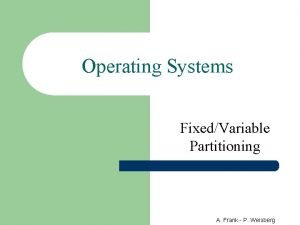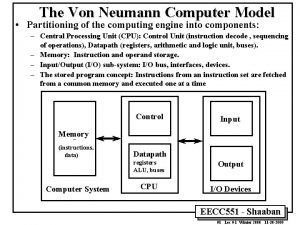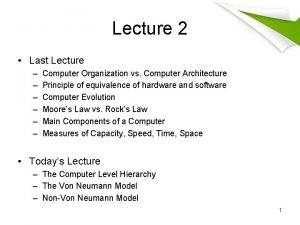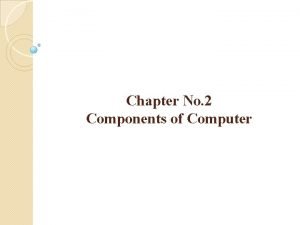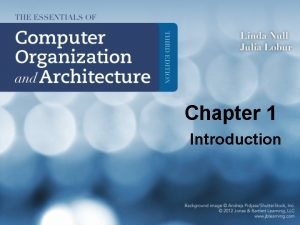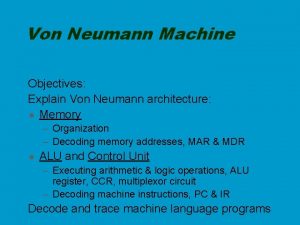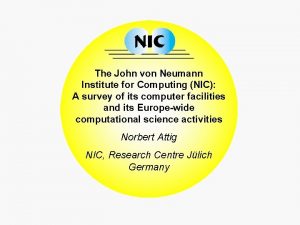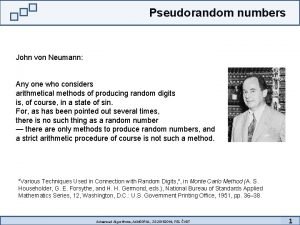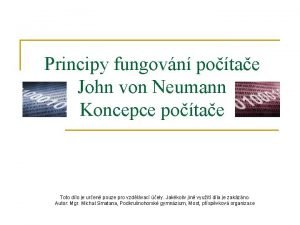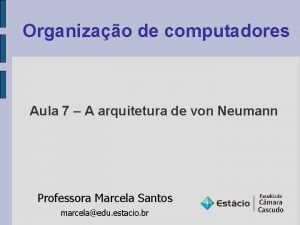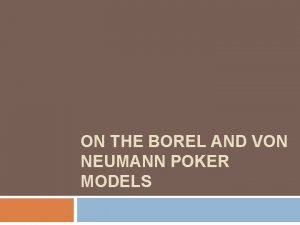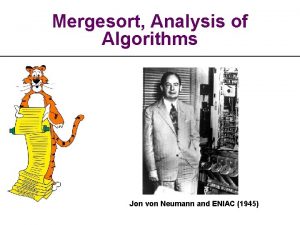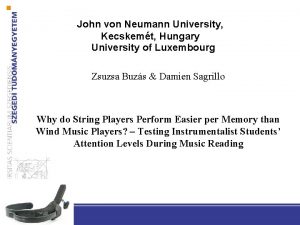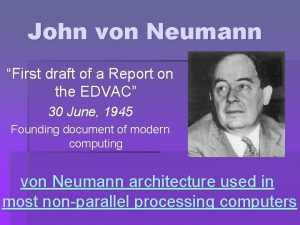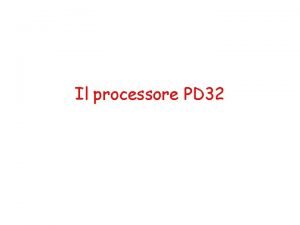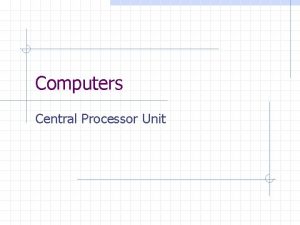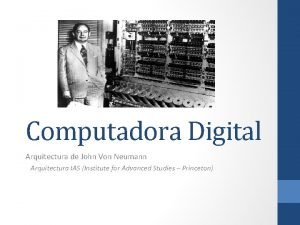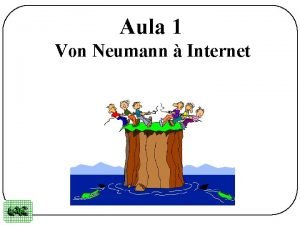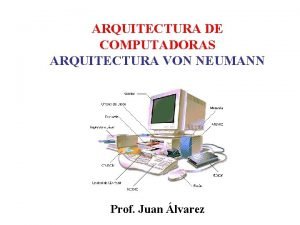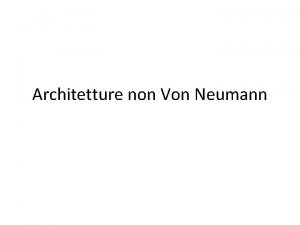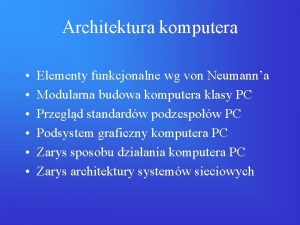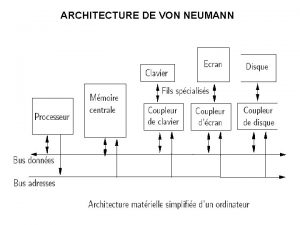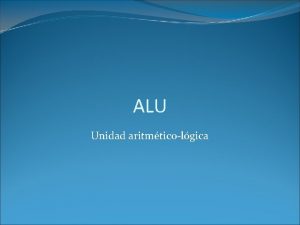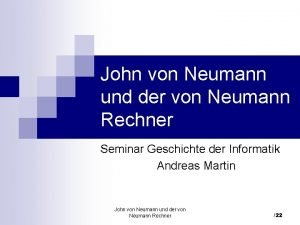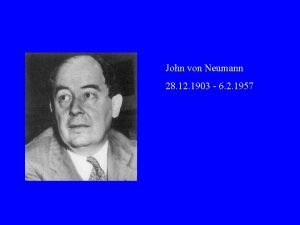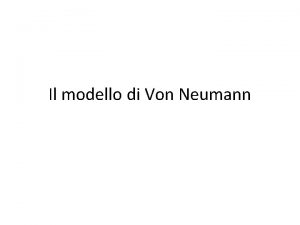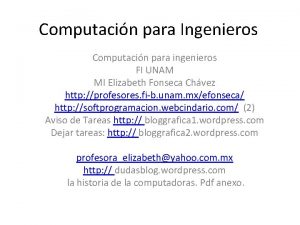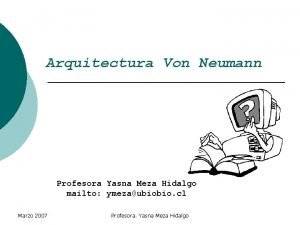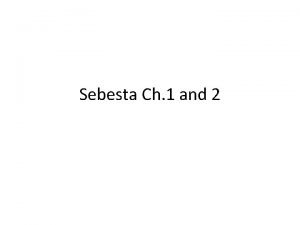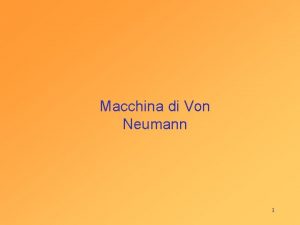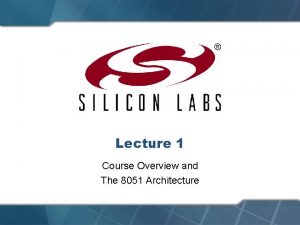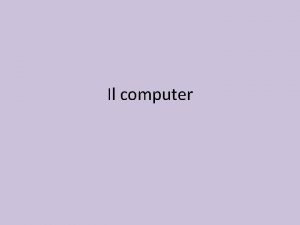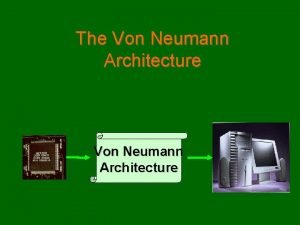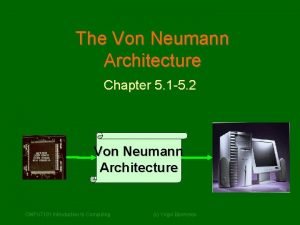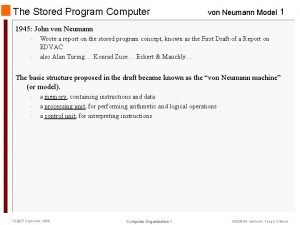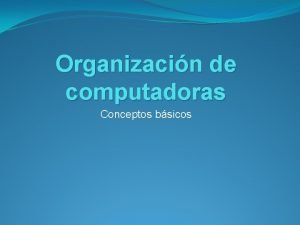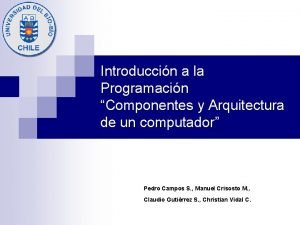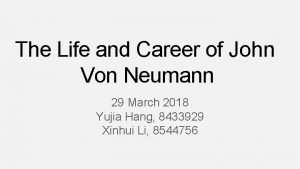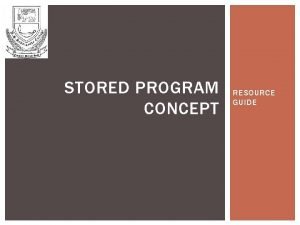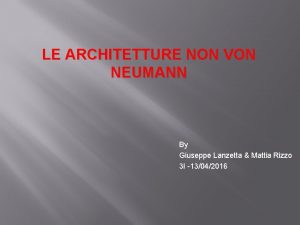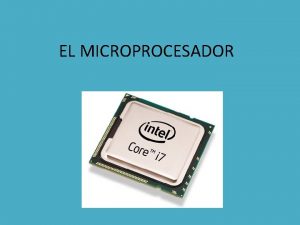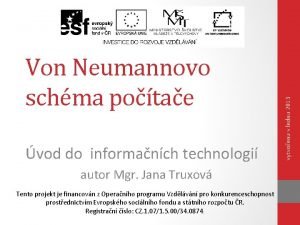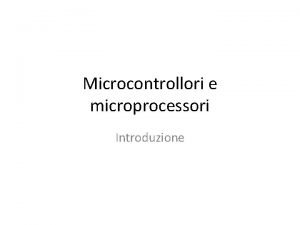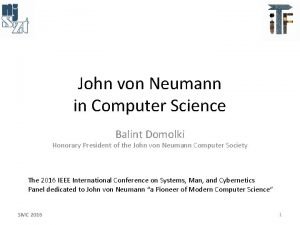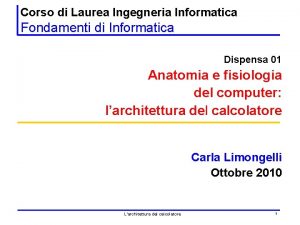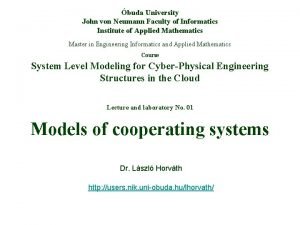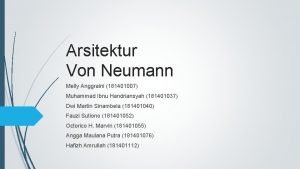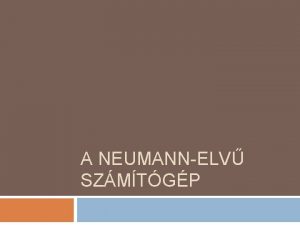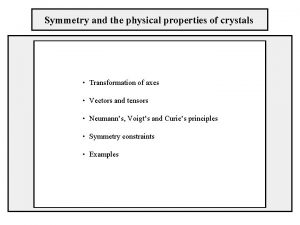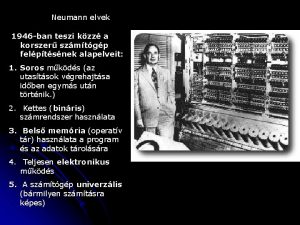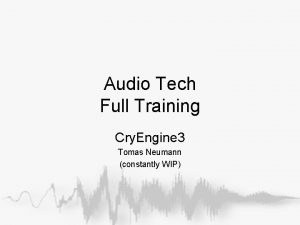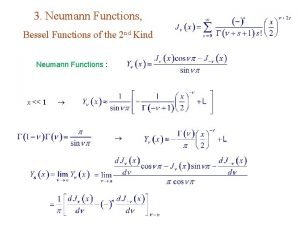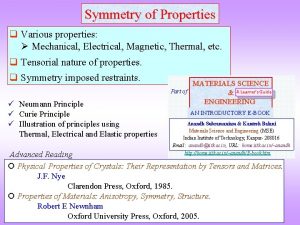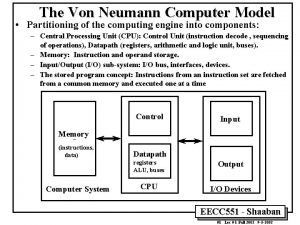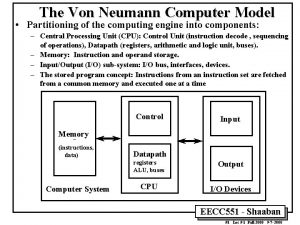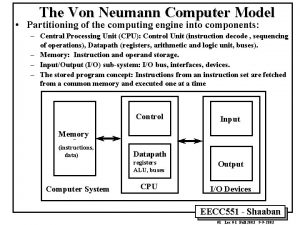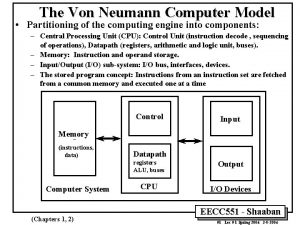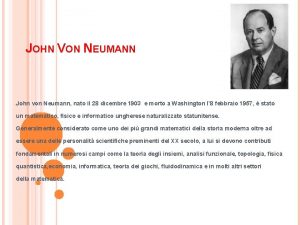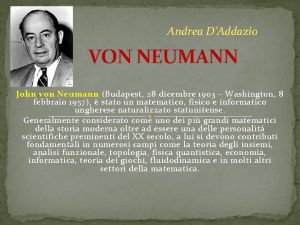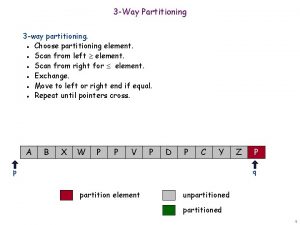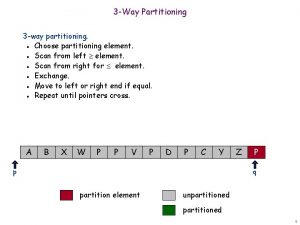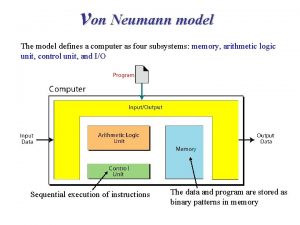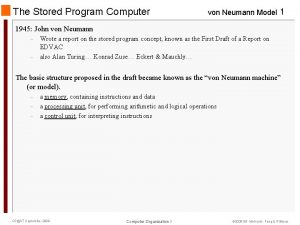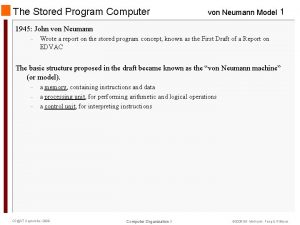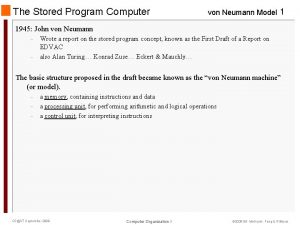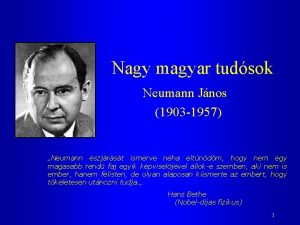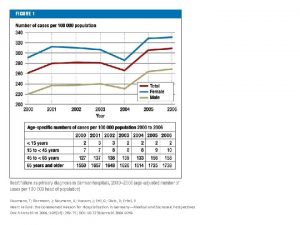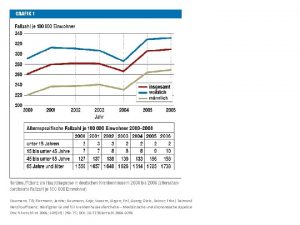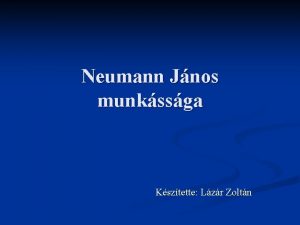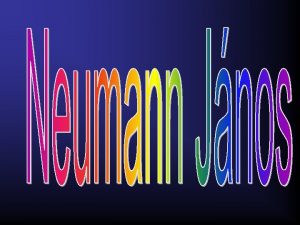The Von Neumann Computer Model Partitioning of the






























































- Slides: 62

The Von Neumann Computer Model • Partitioning of the computing engine into components: – Central Processing Unit (CPU): Control Unit (instruction decode , sequencing of operations), Datapath (registers, arithmetic and logic unit, buses). – Memory: Instruction and operand storage. – Input/Output (I/O) sub-system: I/O bus, interfaces, devices. – The stored program concept: Instructions from an instruction set are fetched from a common memory and executed one at a time Control Input Memory (instructions, data) Computer System Datapath registers ALU, buses Output CPU I/O Devices EECC 551 - Shaaban #1 Lec # 1 Winter 2000 11 -30 -2000

Generic CPU Machine Instruction Execution Steps Instruction Fetch Instruction Decode Operand Fetch Execute Result Store Next Instruction Obtain instruction from program storage Determine required actions and instruction size Locate and obtain operand data Compute result value or status Deposit results in storage for later use Determine successor or next instruction EECC 551 - Shaaban #2 Lec # 1 Winter 2000 11 -30 -2000

Hardware Components of Any Computer Five classic components of all computers: 1. Control Unit; 2. Datapath; 3. Memory; 4. Input; 5. Output } Processor Computer Processor (active) Control Unit Datapath Memory (passive) (where programs, data live when running) Devices Keyboard, Mouse, etc. Input Disk Output Display, Printer, etc. EECC 551 - Shaaban #3 Lec # 1 Winter 2000 11 -30 -2000

CPU Organization • Datapath Design: – Capabilities & performance characteristics of principal Functional Units (FUs): • (e. g. , Registers, ALU, Shifters, Logic Units, . . . ) – Ways in which these components are interconnected (buses connections, multiplexors, etc. ). – How information flows between components. • Control Unit Design: – Logic and means by which such information flow is controlled. – Control and coordination of FUs operation to realize the targeted Instruction Set Architecture to be implemented (can either be implemented using a finite state machine or a microprogram). • Hardware description with a suitable language, possibly using Register Transfer Notation (RTN). EECC 551 - Shaaban #4 Lec # 1 Winter 2000 11 -30 -2000

Recent Trends in Computer Design • The cost/performance ratio of computing systems have seen a steady decline due to advances in: – Integrated circuit technology: decreasing feature size, � • Clock rate improves roughly proportional to improvement in • Number of transistors improves proportional to (or faster). – Architectural improvements in CPU design. • Microprocessor systems directly reflect IC improvement in terms of a yearly 35 to 55% improvement in performance. • Assembly language has been mostly eliminated and replaced by other alternatives such as C or C++ • Standard operating Systems (UNIX, NT) lowered the cost of introducing new architectures. • Emergence of RISC architectures and RISC-core architectures. • Adoption of quantitative approaches to computer design based on empirical performance observations. EECC 551 - Shaaban #5 Lec # 1 Winter 2000 11 -30 -2000

1988 Computer Food Chain Mainframe Supercomputer Minisupercomputer Work- PC Ministation computer Massively Parallel Processors EECC 551 - Shaaban #6 Lec # 1 Winter 2000 11 -30 -2000

Massively Parallel Processors Minisupercomputer Minicomputer 1997 Computer Food Chain Mainframe PDA Server Work- PC station Supercomputer EECC 551 - Shaaban #7 Lec # 1 Winter 2000 11 -30 -2000

Processor Performance Trends Mass-produced microprocessors a cost-effective high-performance replacement for custom-designed mainframe/minicomputer CPUs 1000 Supercomputers 100 Mainframes 10 Minicomputers Microprocessors 1 0. 1 1965 1970 1975 1980 1985 Year 1990 1995 2000 EECC 551 - Shaaban #8 Lec # 1 Winter 2000 11 -30 -2000

Microprocessor Performance 1987 -97 Integer SPEC 92 Performance EECC 551 - Shaaban #9 Lec # 1 Winter 2000 11 -30 -2000

Microprocessor Frequency Trend ÊFrequency doubles each generation ËNumber of gates/clock reduce by 25% EECC 551 - Shaaban #10 Lec # 1 Winter 2000 11 -30 -2000

Microprocessor Transistor Count Growth Rate Moore’s Law Alpha 21264: 15 million Pentium Pro: 5. 5 million Power. PC 620: 6. 9 million Alpha 21164: 9. 3 million Sparc Ultra: 5. 2 million Moore’s Law: 2 X transistors/Chip Every 1. 5 years EECC 551 - Shaaban #11 Lec # 1 Winter 2000 11 -30 -2000

Increase of Capacity of VLSI Dynamic RAM Chips year size(Megabit) 1980 1983 1986 1989 1992 1996 1999 2000 0. 0625 0. 25 1 4 16 64 256 1024 1. 55 X/yr, or doubling every 1. 6 years EECC 551 - Shaaban #12 Lec # 1 Winter 2000 11 -30 -2000

DRAM Cost Over Time Current second half 1999 cost: ~ $1 per MB EECC 551 - Shaaban #13 Lec # 1 Winter 2000 11 -30 -2000

Recent Technology Trends (Summary) Capacity Speed (latency) Logic 2 x in 3 years DRAM 4 x in 3 years 2 x in 10 years Disk 2 x in 10 years 4 x in 3 years EECC 551 - Shaaban #14 Lec # 1 Winter 2000 11 -30 -2000

Computer Technology Trends: Evolutionary but Rapid Change • Processor: – 2 X in speed every 1. 5 years; 1000 X performance in last decade. • Memory: – DRAM capacity: > 2 x every 1. 5 years; 1000 X size in last decade. – Cost per bit: Improves about 25% per year. • Disk: – – Capacity: > 2 X in size every 1. 5 years. Cost per bit: Improves about 60% per year. 200 X size in last decade. Only 10% performance improvement per year, due to mechanical limitations. • Expected State-of-the-art PC by end of year 2000 : – Processor clock speed: – Memory capacity: – Disk capacity: > 1500 Mega. Hertz (1. 5 Giga. Hertz) > 500 Mega. Byte (0. 5 Giga. Bytes) > 100 Giga. Bytes (0. 1 Tera. Bytes) EECC 551 - Shaaban #15 Lec # 1 Winter 2000 11 -30 -2000

Distribution of Cost in a System: An Example Decreasing fraction of total cost Increasing fraction of total cost EECC 551 - Shaaban #16 Lec # 1 Winter 2000 11 -30 -2000

A Simplified View of The Software/Hardware Hierarchical Layers EECC 551 - Shaaban #17 Lec # 1 Winter 2000 11 -30 -2000

A Hierarchy of Computer Design Level 1 Name Modules Electronics Gates, FF’s 2 Logic 3 Organization Registers, ALU’s. . . Processors, Memories Primitives Descriptive Media Transistors, Resistors, etc. Gates, FF’s …. Logic Diagrams Registers, ALU’s … Low Level - Hardware 4 Microprogramming Assembly Language Circuit Diagrams Microinstructions Register Transfer Notation (RTN) Microprogram Firmware 5 Assembly language programming 6 Procedural Programming 7 Application OS Routines Applications Drivers. . Systems Assembly language Instructions Assembly Language Programs OS Routines High-level Language Programs Procedural Constructs Problem-Oriented Programs High Level - Software EECC 551 - Shaaban #18 Lec # 1 Winter 2000 11 -30 -2000

Hierarchy of Computer Architecture High-Level Language Programs Software Application Operating System Machine Language Program Software/Hardware Boundary Assembly Language Programs Compiler Firmware Instr. Set Proc. I/O system Instruction Set Architecture Datapath & Control Hardware Digital Design Circuit Design Microprogram Layout Logic Diagrams Circuit Diagrams Register Transfer Notation (RTN) EECC 551 - Shaaban #19 Lec # 1 Winter 2000 11 -30 -2000

Computer Architecture Vs. Computer Organization • The term Computer architecture is sometimes erroneously restricted to computer instruction set design, with other aspects of computer design called implementation • More accurate definitions: – Instruction set architecture (ISA): The actual programmervisible instruction set and serves as the boundary between the software and hardware. – Implementation of a machine has two components: • Organization: includes the high-level aspects of a computer’s design such as: The memory system, the bus structure, the internal CPU unit which includes implementations of arithmetic, logic, branching, and data transfer operations. • Hardware: Refers to the specifics of the machine such as detailed logic design and packaging technology. • In general, Computer Architecture refers to the above three aspects: Instruction set architecture, organization, and hardware. EECC 551 - Shaaban #20 Lec # 1 Winter 2000 11 -30 -2000

Computer Architecture’s Changing Definition • 1950 s to 1960 s: Computer Architecture Course = Computer Arithmetic. • 1970 s to mid 1980 s: Computer Architecture Course = Instruction Set Design, especially ISA appropriate for compilers. • 1990 s: Computer Architecture Course = Design of CPU, memory system, I/O system, Multiprocessors. EECC 551 - Shaaban #21 Lec # 1 Winter 2000 11 -30 -2000

The Task of A Computer Designer • Determine what attributes that are important to the design of the new machine. • Design a machine to maximize performance while staying within cost and other constraints and metrics. • It involves more than instruction set design. – Instruction set architecture. – CPU Micro-Architecture. – Implementation. • Implementation of a machine has two components: – Organization. – Hardware. EECC 551 - Shaaban #22 Lec # 1 Winter 2000 11 -30 -2000

Recent Architectural Improvements • Increased optimization and utilization of cache systems. • Memory-latency hiding techniques. • Optimization of pipelined instruction execution. • Dynamic hardware-based pipeline scheduling. • Improved handling of pipeline hazards. • Improved hardware branch prediction techniques. • Exploiting Instruction-Level Parallelism (ILP) in terms of multiple-instruction issue and multiple hardware functional units. • Inclusion of special instructions to handle multimedia applications. • High-speed bus designs to improve data transfer rates. EECC 551 - Shaaban #23 Lec # 1 Winter 2000 11 -30 -2000

The Concept of Memory Hierarchy CPU Registers C a c h e < 4 MB Memory < 4 GB 60 ns I/O dev. >2 GB 5 ms EECC 551 - Shaaban #24 Lec # 1 Winter 2000 11 -30 -2000

Typical Parameters of Memory Hierarchy Levels EECC 551 - Shaaban #25 Lec # 1 Winter 2000 11 -30 -2000

Current Computer Architecture Topics Input/Output and Storage Disks, WORM, Tape Emerging Technologies Interleaving Bus protocols DRAM Memory Hierarchy VLSI Coherence, Bandwidth, Latency L 2 Cache L 1 Cache Instruction Set Architecture Addressing, Protection, Exception Handling Pipelining, Hazard Resolution, Superscalar, Reordering, Branch Prediction, Speculation, VLIW, Vector, DSP, . . . Multiprocessing, Simultaneous CPU Multi-threading RAID Pipelining and Instruction Level Parallelism (ILP) Thread Level Parallelism (TLB) EECC 551 - Shaaban #26 Lec # 1 Winter 2000 11 -30 -2000

Computer Performance Evaluation: Cycles Per Instruction (CPI) • Most computers run synchronously utilizing a CPU clock running at a constant clock rate: where: Clock rate = 1 / clock cycle • A computer machine instruction is comprised of a number of elementary or micro operations which vary in number and complexity depending on the instruction and the exact CPU organization and implementation. – A micro operation is an elementary hardware operation that can be performed during one clock cycle. – This corresponds to one micro-instruction in microprogrammed CPUs. – Examples: register operations: shift, load, clear, increment, ALU operations: add , subtract, etc. • Thus a single machine instruction may take one or more cycles to complete termed as the Cycles Per Instruction (CPI). EECC 551 - Shaaban #27 Lec # 1 Winter 2000 11 -30 -2000

Computer Performance Measures: Program Execution Time • For a specific program compiled to run on a specific machine “A”, the following parameters are provided: – The total instruction count of the program. – The average number of cycles per instruction (average CPI). – Clock cycle of machine “A” • How can one measure the performance of this machine running this program? – Intuitively the machine is said to be faster or has better performance running this program if the total execution time is shorter. – Thus the inverse of the total measured program execution time is a possible performance measure or metric: Performance. A = 1 / Execution Time. A How to compare performance of different machines? What factors affect performance? How to improve performance? EECC 551 - Shaaban #28 Lec # 1 Winter 2000 11 -30 -2000

Measuring Performance • For a specific program or benchmark running on machine x: Performance = 1 / Execution Timex • To compare the performance of machines X, Y, executing specific code: n = Executiony / Executionx = Performance x / Performancey • System performance refers to the performance and elapsed time measured on an unloaded machine. • • CPU Performance refers to user CPU time on an unloaded system. Example: For a given program: Execution time on machine A: Execution. A = 1 second Execution time on machine B: Execution. B = 10 seconds Performance. A /Performance. B = Execution Time. B /Execution Time. A = 10 /1 = 10 The performance of machine A is 10 times the performance of machine B when running this program, or: Machine A is said to be 10 times faster than machine B when running this program. EECC 551 - Shaaban #29 Lec # 1 Winter 2000 11 -30 -2000

CPU Performance Equation CPU time = CPU clock cycles for a program X Clock cycle time or: CPU time = CPU clock cycles for a program / clock rate CPI (clock cycles per instruction): CPI = CPU clock cycles for a program / I where I is the instruction count. EECC 551 - Shaaban #30 Lec # 1 Winter 2000 11 -30 -2000

CPU Execution Time: The CPU Equation • A program is comprised of a number of instructions, I – Measured in: instructions/program • The average instruction takes a number of cycles per instruction (CPI) to be completed. – Measured in: cycles/instruction • CPU has a fixed clock cycle time C = 1/clock rate – Measured in: seconds/cycle • CPU execution time is the product of the above three parameters as follows: CPU Time = I x CPI x C CPU time = Seconds Program = Instructions x Cycles Program x Seconds Instruction Cycle EECC 551 - Shaaban #31 Lec # 1 Winter 2000 11 -30 -2000

CPU Execution Time For a given program and machine: CPI = Total program execution cycles / Instructions count ® CPU clock cycles = Instruction count x CPI CPU execution time = = CPU clock cycles x Clock cycle = Instruction count x CPI x Clock cycle = I x CPI x C EECC 551 - Shaaban #32 Lec # 1 Winter 2000 11 -30 -2000

CPU Execution Time: Example • A Program is running on a specific machine with the following parameters: – Total instruction count: 10, 000 instructions – Average CPI for the program: 2. 5 cycles/instruction. – CPU clock rate: 200 MHz. • What is the execution time for this program: CPU time = Seconds Program = Instructions x Cycles Program x Seconds Instruction Cycle CPU time = Instruction count x CPI x Clock cycle = 10, 000 x 2. 5 x 1 / clock rate = 10, 000 x 2. 5 x 5 x 10 -9 =. 125 seconds EECC 551 - Shaaban #33 Lec # 1 Winter 2000 11 -30 -2000

Aspects of CPU Execution Time CPU Time = Instruction count x CPI x Clock cycle Depends on: Program Used Compiler ISA Instruction Count I Depends on: Program Used Compiler ISA CPU Organization CPI Clock Cycle C Depends on: CPU Organization Technology EECC 551 - Shaaban #34 Lec # 1 Winter 2000 11 -30 -2000

Factors Affecting CPU Performance CPU time = Seconds = Instructions x Cycles Program Instruction Count I CPI Program X X Compiler X X Instruction Set Architecture (ISA) X X Organization Technology x Seconds X Cycle Clock Cycle C X X EECC 551 - Shaaban #35 Lec # 1 Winter 2000 11 -30 -2000

Performance Comparison: Example • From the previous example: A Program is running on a specific machine with the following parameters: – Total instruction count: 10, 000 instructions – Average CPI for the program: 2. 5 cycles/instruction. – CPU clock rate: 200 MHz. • Using the same program with these changes: – A new compiler used: New instruction count 9, 500, 000 New CPI: 3. 0 – Faster CPU implementation: New clock rate = 300 MHZ • What is the speedup with the changes? Speedup = Old Execution Time = Iold x New Execution Time Inew x CPIold x Clock cycleold CPInew x Clock Cyclenew Speedup = (10, 000 x 2. 5 x 5 x 10 -9) / (9, 500, 000 x 3. 33 x 10 -9 ) =. 125 /. 095 = 1. 32 or 32 % faster after changes. EECC 551 - Shaaban #36 Lec # 1 Winter 2000 11 -30 -2000

Instruction Types And CPI • Given a program with n types or classes of instructions with: – Ci = Count of instructions of typei – CPIi = Average cycles per instruction of typei EECC 551 - Shaaban #37 Lec # 1 Winter 2000 11 -30 -2000

Instruction Types And CPI: An Example • An instruction set has three instruction classes: Instruction class A B C CPI 1 2 3 • Two code sequences have the following instruction counts: Code Sequence 1 2 Instruction counts for instruction class A B C 2 1 2 4 1 1 • CPU cycles for sequence 1 = 2 x 1 + 1 x 2 + 2 x 3 = 10 cycles CPI for sequence 1 = clock cycles / instruction count = 10 /5 = 2 • CPU cycles for sequence 2 = 4 x 1 + 1 x 2 + 1 x 3 = 9 cycles CPI for sequence 2 = 9 / 6 = 1. 5 EECC 551 - Shaaban #38 Lec # 1 Winter 2000 11 -30 -2000

Instruction Frequency & CPI • Given a program with n types or classes of instructions with the following characteristics: Ci = Count of instructions of typei CPIi = Average cycles per instruction of typei Fi = Frequency of instruction typei = Ci / total instruction count Then: EECC 551 - Shaaban #39 Lec # 1 Winter 2000 11 -30 -2000

Instruction Type Frequency & CPI: A RISC Example Base Machine (Reg / Reg) Op Freq Cycles CPIx. F ALU 50% 1. 5 Load 20% 5 1. 0 Store 10% 3. 3 Branch 20% 2. 4 % Time 23% 45% 14% 18% Typical Mix CPI =. 5 x 1 +. 2 x 5 +. 1 x 3 +. 2 x 2 = 2. 2 EECC 551 - Shaaban #40 Lec # 1 Winter 2000 11 -30 -2000

Metrics of Computer Performance Execution time: Target workload, SPEC 95, etc. Application Programming Language Compiler ISA (millions) of Instructions per second – MIPS (millions) of (F. P. ) operations per second – MFLOP/s Datapath Control Megabytes per second. Function Units Transistors Wires Pins Cycles per second (clock rate). Each metric has a purpose, and each can be misused. EECC 551 - Shaaban #41 Lec # 1 Winter 2000 11 -30 -2000

Choosing Programs To Evaluate Performance Levels of programs or benchmarks that could be used to evaluate performance: – Actual Target Workload: Full applications that run on the target machine. – Real Full Program-based Benchmarks: • Select a specific mix or suite of programs that are typical of targeted applications or workload (e. g SPEC 95). – Small “Kernel” Benchmarks: • Key computationally-intensive pieces extracted from real programs. – Examples: Matrix factorization, FFT, tree search, etc. • Best used to test specific aspects of the machine. – Microbenchmarks: • Small, specially written programs to isolate a specific aspect of performance characteristics: Processing: integer, floating point, local memory, input/output, etc. EECC 551 - Shaaban #42 Lec # 1 Winter 2000 11 -30 -2000

Pros Types of Benchmarks • Representative • Portable. • Widely used. • Measurements useful in reality. Actual Target Workload Full Application Benchmarks • Easy to run, early in the design cycle. • Identify peak performance and potential bottlenecks. Small “Kernel” Benchmarks Microbenchmarks Cons • Very specific. • Non-portable. • Complex: Difficult to run, or measure. • Less representative than actual workload. • Easy to “fool” by designing hardware to run them well. • Peak performance results may be a long way from real application performance EECC 551 - Shaaban #43 Lec # 1 Winter 2000 11 -30 -2000

SPEC: System Performance Evaluation Cooperative • The most popular and industry-standard set of CPU benchmarks. • SPECmarks, 1989: – 10 programs yielding a single number (“SPECmarks”). • SPEC 92, 1992: – SPECInt 92 (6 integer programs) and SPECfp 92 (14 floating point programs). • SPEC 95, 1995: – Eighteen new application benchmarks selected (with given inputs) reflecting a technical computing workload. – SPECint 95 (8 integer programs): • go, m 88 ksim, gcc, compress, li, ijpeg, perl, vortex – SPECfp 95 (10 floating-point intensive programs): • tomcatv, swim, su 2 cor, hydro 2 d, mgrid, applu, turb 3 d, apsi, fppp, wave 5 – Source code must be compiled with standard compiler flags. EECC 551 - Shaaban #44 Lec # 1 Winter 2000 11 -30 -2000

SPEC 95 Integer Floating Point EECC 551 - Shaaban #45 Lec # 1 Winter 2000 11 -30 -2000

SPEC 95 For High-End CPUs Fourth Quarter 1999 EECC 551 - Shaaban #46 Lec # 1 Winter 2000 11 -30 -2000

Expected SPEC 95 For High-End CPUs First Quarter 2000 EECC 551 - Shaaban #47 Lec # 1 Winter 2000 11 -30 -2000

Comparing and Summarizing Performance • Total execution time of the compared machines. • If n program runs or n programs are used: – Arithmetic mean: – Weighted Execution Time: – Normalized Execution time (arithmetic or geometric mean). Formula for geometric mean: EECC 551 - Shaaban #48 Lec # 1 Winter 2000 11 -30 -2000

Computer Performance Measures : MIPS (Million Instructions Per Second) • For a specific program running on a specific computer is a measure of millions of instructions executed per second: MIPS = = Instruction count / (Execution Time x 106) Instruction count / (CPU clocks x Cycle time x 106) (Instruction count x Clock rate) / (Instruction count x CPI x 106) Clock rate / (CPI x 106) • Faster execution time usually means faster MIPS rating. • Problems: – No account for instruction set used. – Program-dependent: A single machine does not have a single MIPS rating. – Cannot be used to compare computers with different instruction sets. – A higher MIPS rating in some cases may not mean higher performance or better execution time. i. e. due to compiler design variations. EECC 551 - Shaaban #49 Lec # 1 Winter 2000 11 -30 -2000

Compiler Variations, MIPS, Performance: An Example • For the machine with instruction classes: Instruction class A B C CPI 1 2 3 • For a given program two compilers produced the following instruction counts: Code from: Compiler 1 Compiler 2 Instruction counts (in millions) for each instruction class A B C 5 1 1 10 1 1 • The machine is assumed to run at a clock rate of 100 MHz EECC 551 - Shaaban #50 Lec # 1 Winter 2000 11 -30 -2000

Compiler Variations, MIPS, Performance: An Example (Continued) MIPS = Clock rate / (CPI x 106) = 100 MHz / (CPI x 106) CPI = CPU execution cycles / Instructions count CPU time = Instruction count x CPI / Clock rate • For compiler 1: – CPI 1 = (5 x 1 + 1 x 2 + 1 x 3) / (5 + 1) = 10 / 7 = 1. 43 – MIP 1 = 100 / (1. 428 x 106) = 70. 0 – CPU time 1 = ((5 + 1) x 106 x 1. 43) / (100 x 106) = 0. 10 seconds • For compiler 2: – CPI 2 = (10 x 1 + 1 x 2 + 1 x 3) / (10 + 1) = 15 / 12 = 1. 25 – MIP 2 = 100 / (1. 25 x 106) = 80. 0 – CPU time 2 = ((10 + 1) x 106 x 1. 25) / (100 x 106) = 0. 15 seconds EECC 551 - Shaaban #51 Lec # 1 Winter 2000 11 -30 -2000

Computer Performance Measures : MFOLPS (Million FLOating-Point Operations Per Second) • A floating-point operation is an addition, subtraction, multiplication, or division operation applied to numbers represented by a single or double precision floating-point representation. • MFLOPS, for a specific program running on a specific computer, is a measure of millions of floating point-operation (megaflops) per second: MFLOPS = Number of floating-point operations / (Execution time x 106 ) • A better comparison measure between different machines than MIPS. • Program-dependent: Different programs have different percentages of floating-point operations present. i. e compilers have no such operations and yield a MFLOPS rating of zero. • Dependent on the type of floating-point operations present in the program. EECC 551 - Shaaban #52 Lec # 1 Winter 2000 11 -30 -2000

Quantitative Principles of Computer Design • Amdahl’s Law: The performance gain from improving some portion of a computer is calculated by: Speedup = Performance for entire task using the enhancement Performance for the entire task without using the enhancement or Speedup = Execution time without the enhancement Execution time for entire task using the enhancement EECC 551 - Shaaban #53 Lec # 1 Winter 2000 11 -30 -2000

Performance Enhancement Calculations: Amdahl's Law • The performance enhancement possible due to a given design improvement is limited by the amount that the improved feature is used • Amdahl’s Law: Performance improvement or speedup due to enhancement E: Execution Time without E Speedup(E) = -------------------Execution Time with E Performance with E = ----------------Performance without E – Suppose that enhancement E accelerates a fraction F of the execution time by a factor S and the remainder of the time is unaffected then: Execution Time with E = ((1 -F) + F/S) X Execution Time without E Hence speedup is given by: Execution Time without E 1 Speedup(E) = ----------------------------- = ----------((1 - F) + F/S) X Execution Time without E (1 - F) + F/S EECC 551 - Shaaban #54 Lec # 1 Winter 2000 11 -30 -2000

Pictorial Depiction of Amdahl’s Law Enhancement E accelerates fraction F of execution time by a factor of S Before: Execution Time without enhancement E: Unaffected, fraction: (1 - F) Affected fraction: F Unchanged Unaffected, fraction: (1 - F) F/S After: Execution Time with enhancement E: Execution Time without enhancement E 1 Speedup(E) = --------------------------- = ---------Execution Time with enhancement E (1 - F) + F/S EECC 551 - Shaaban #55 Lec # 1 Winter 2000 11 -30 -2000

Performance Enhancement Example • For the RISC machine with the following instruction mix given earlier: Op ALU Load Store Branch Freq 50% 20% 10% 20% Cycles 1 5 3 2 CPI(i). 5 1. 0. 3. 4 % Time 23% 45% 14% 18% CPI = 2. 2 • If a CPU design enhancement improves the CPI of load instructions from 5 to 2, what is the resulting performance improvement from this enhancement: Fraction enhanced = F = 45% or. 45 Unaffected fraction = 100% - 45% = 55% or. 55 Factor of enhancement = 5/2 = 2. 5 Using Amdahl’s Law: 1 1 Speedup(E) = --------------------- = (1 - F) + F/S. 55 +. 45/2. 5 1. 37 EECC 551 - Shaaban #56 Lec # 1 Winter 2000 11 -30 -2000

An Alternative Solution Using CPU Equation Op ALU Load Store Branch Freq 50% 20% 10% 20% Cycles 1 5 3 2 CPI(i). 5 1. 0. 3. 4 % Time 23% 45% 14% 18% CPI = 2. 2 • If a CPU design enhancement improves the CPI of load instructions from 5 to 2, what is the resulting performance improvement from this enhancement: Old CPI = 2. 2 New CPI =. 5 x 1 +. 2 x 2 +. 1 x 3 +. 2 x 2 = 1. 6 Original Execution Time Speedup(E) = -----------------New Execution Time Instruction count x old CPI x clock cycle = --------------------------------Instruction count x new CPI x clock cycle old CPI = ------ = new CPI 2. 2 ----1. 6 = 1. 37 Which is the same speedup obtained from Amdahl’s Law in the first solution. EECC 551 - Shaaban #57 Lec # 1 Winter 2000 11 -30 -2000

Performance Enhancement Example • A program runs in 100 seconds on a machine with multiply operations responsible for 80 seconds of this time. By how much must the speed of multiplication be improved to make the program four times faster? Desired speedup = 4 = ® 100 --------------------------Execution Time with enhancement Execution time with enhancement = 25 seconds = (100 - 80 seconds) + 80 seconds / n 25 seconds = 20 seconds + 80 seconds / n ® ® 5 = 80 seconds / n n = 80/5 = 16 Hence multiplication should be 16 times faster to get a speedup of 4. EECC 551 - Shaaban #58 Lec # 1 Winter 2000 11 -30 -2000

Performance Enhancement Example • For the previous example with a program running in 100 seconds on a machine with multiply operations responsible for 80 seconds of this time. By how much must the speed of multiplication be improved to make the program five times faster? Desired speedup = 5 = ® 100 --------------------------Execution Time with enhancement Execution time with enhancement = 20 seconds = (100 - 80 seconds) + 80 seconds / n 20 seconds = 20 seconds + 80 seconds / n ® 0 = 80 seconds / n No amount of multiplication speed improvement can achieve this. EECC 551 - Shaaban #59 Lec # 1 Winter 2000 11 -30 -2000

Extending Amdahl's Law To Multiple Enhancements • Suppose that enhancement Ei accelerates a fraction Fi of the execution time by a factor Si and the remainder of the time is unaffected then: Note: All fractions refer to original execution time. EECC 551 - Shaaban #60 Lec # 1 Winter 2000 11 -30 -2000

Amdahl's Law With Multiple Enhancements: Example • Three CPU performance enhancements are proposed with the following speedups and percentage of the code execution time affected: Speedup 1 = S 1 = 10 Speedup 2 = S 2 = 15 Speedup 3 = S 3 = 30 • • • Percentage 1 = F 1 = 20% Percentage 1 = F 2 = 15% Percentage 1 = F 3 = 10% While all three enhancements are in place in the new design, each enhancement affects a different portion of the code and only one enhancement can be used at a time. What is the resulting overall speedup? Speedup = 1 / [(1 -. 2 -. 15 -. 1) +. 2/10 +. 15/15 +. 1/30)] = 1/ [. 55 +. 0333 ] = 1 /. 5833 = 1. 71 EECC 551 - Shaaban #61 Lec # 1 Winter 2000 11 -30 -2000

Pictorial Depiction of Example Before: Execution Time with no enhancements: 1 Unaffected, fraction: . 55 S 1 = 10 F 1 =. 2 S 2 = 15 S 3 = 30 F 2 =. 15 F 3 =. 1 / 15 / 10 / 30 Unchanged Unaffected, fraction: . 55 After: Execution Time with enhancements: . 55 +. 02 +. 01 +. 00333 =. 5833 Speedup = 1 /. 5833 = 1. 71 Note: All fractions refer to original execution time. EECC 551 - Shaaban #62 Lec # 1 Winter 2000 11 -30 -2000
 Fixed partitioning and dynamic partitioning
Fixed partitioning and dynamic partitioning Von neumann model components
Von neumann model components Non von neumann model
Non von neumann model Von neumann model components
Von neumann model components Non von neumann model
Non von neumann model Characteristics of von neumann architecture
Characteristics of von neumann architecture John von neumann institute
John von neumann institute John von neumann random number generator
John von neumann random number generator John von neumann schema
John von neumann schema Gargalo de von neumann
Gargalo de von neumann John von neumann poker
John von neumann poker Jon von neumann
Jon von neumann John von neumann university
John von neumann university Computer history
Computer history John louis von neumann
John louis von neumann Modello di von neumann spiegazione semplice
Modello di von neumann spiegazione semplice Von neumann
Von neumann Arquitectura de von neumann
Arquitectura de von neumann Estrutura de von neumann
Estrutura de von neumann Estructura general del computador ias
Estructura general del computador ias Architettura harvard
Architettura harvard Architektura neumanna
Architektura neumanna Von neumann test
Von neumann test Modelo john von neumann
Modelo john von neumann Von neumann rechner simulation
Von neumann rechner simulation John von neumann algorithm
John von neumann algorithm Schema von neumann
Schema von neumann Modelo de von neumann unam
Modelo de von neumann unam Von neumann
Von neumann Von neumannova schéma počítača
Von neumannova schéma počítača Von neumann
Von neumann La macchina di von neumann
La macchina di von neumann 8051 architecture
8051 architecture Computer 1945
Computer 1945 Sisd example
Sisd example Architecture von neumann nsi
Architecture von neumann nsi Nguyên lý von neumann
Nguyên lý von neumann Modello von neumann
Modello von neumann Von neumann architecture
Von neumann architecture Neumann dst
Neumann dst Modelo de von neumann
Modelo de von neumann Mapa mental de software y hardware
Mapa mental de software y hardware Jon von neumann
Jon von neumann Stored program control concept
Stored program control concept Non von neumann architecture
Non von neumann architecture Estructura von neumann
Estructura von neumann Von neumann ratio test
Von neumann ratio test Von neumannovo schéma
Von neumannovo schéma La macchina di von neumann
La macchina di von neumann Jon von neumann
Jon von neumann La macchina di von neumann
La macchina di von neumann Jnfi
Jnfi Pengertian arsitektur von neumann
Pengertian arsitektur von neumann Wind von backbord weicht wind von steuerbord
Wind von backbord weicht wind von steuerbord Erasmus von rotterdam beeinflusst von
Erasmus von rotterdam beeinflusst von Neumann elvű számítógép felépítése
Neumann elvű számítógép felépítése Noelle-neumann 1974
Noelle-neumann 1974 Neumann's principle
Neumann's principle Neumann elvek
Neumann elvek Tomas neumann
Tomas neumann Wronskian
Wronskian Neumann's principle
Neumann's principle Teresa neumann visiones
Teresa neumann visiones
